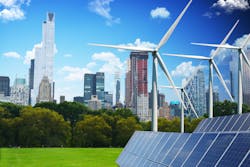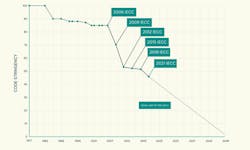Whether buildings of the future have massively scaled back carbon footprints may turn on developments with building energy codes, a locus of growing attention and debate.
One, the International Energy Conservation Code (IECC), is in the latter stages of its triennial revision and could ultimately incorporate requirements that widen the code’s scope from simply energy savings and efficiency to include aggressive decarbonization strategies. Proposals that the code, sponsored by the International Code Council (ICC), address building renewable energy and energy storage; electric vehicle charging infrastructure; and grid integration through demand response technology are among many under consideration as the public comment period for the 2024 IECC heads toward its October 21, 2022 conclusion.
New Buildings Institute, the Portland, Ore., group that promotes zero-energy buildings and has led the charge to get a decarbonization/climate change focus into the draft code, won’t say victory is at hand.
“We expect several climate-aligned proposals such as electric vehicle (EV) infrastructure, renewable energy requirements, and energy storage readiness requirements to receive pushback from opponents in the public comment period,” reads an appeal posted on NBI’s website for supporters to weigh in.
NBI’s concern stems partly from changes in the process for updating the IECC, which about 30 states have on the books but in mostly dated versions. The 2024 revision marks the first time ICC relies on a broad mix of stakeholders to reach consensus. Until this round, government officials from states and municipalities voted on which proposals to adopt. Now, the responsibility lies with committees representing a variety of additional interested parties. Included in that new contingent are those representing cost-conscious commercial interests such as builders, a group NBI and other aligned parties worry could block efforts to tilt the code’s trajectory and mission.
In a September 8 post on The American Council for an Energy-Efficient Economy’s (ACEE) website, senior buildings manager Michael Waite writes that the “new process adopted for the current cycle limits the influence of sustainability- and civic-minded state and local officials who have delivered major efficiency gains in recent code cycles.” Echoing NBI, he adds that, “with strong energy efficiency and decarbonization gains in the proposed code, we can expect pushback.”
If adopted as written, NBI says, the 2024 IECC would convey sizable gains in efficiency while simultaneously reducing emissions. It projects energy efficiency gains of 8-12% over the current 2021 IECC plus an additional 10-15% reduction in building energy usage tied to more onsite renewable energy and other grid-integrated resources. With buildings accounting for 39% of U.S. carbon emissions a new code with a decarbonization focus could make a sizable dent in the problem and accelerate the movement to net-zero energy usage in buildings (Figure).
On another codes front, NBI has just unveiled its own model code for decarbonizing the nation’s building stock, a follow-up to a broader code it unveiled last year. The new Existing Building Decarbonization Code lays out strategies for specifically retrofitting existing buildings to meet net-zero energy targets. With 5.9 million existing commercial buildings in the U.S. and new construction representing only 2% of annual building activity, NBI says existing buildings should command attention in the decarbonization quest.
“NBI’s release of the Building Decarbonization Code provided the first off-the-shelf solution – as an overlay to the 2021 IECC – for jurisdictions to transform energy codes into decarbonization codes for new buildings. This (new) code complements the original adding provisions specifically for existing buildings. The new model language covers both residential and commercial buildings including all-electric and mix-fuel energy use pathways.”
Meanwhile, building energy code development is getting a new push from the federal government. The U.S. Department of Energy is looking to provide $225 million to help state and local governments expand the implementation of the latest building energy codes and support the development of buildings that use less energy. The Building Energy Codes: Resilient and Efficient Codes Implementation Program grew out of the Bipartisan Infrastructure legislation and supports the administration’s National Initiative to Advance Building Codes, launched in June 2022 by the National Climate Task Force. Getting wider buy-in on more modern energy building codes will cut carbon emissions and lower electricity costs by $138 billion over 30 years, DOE says.
About the Author
Tom Zind
Freelance Writer
Zind is a freelance writer based in Lee’s Summit, Mo. He can be reached at [email protected].

